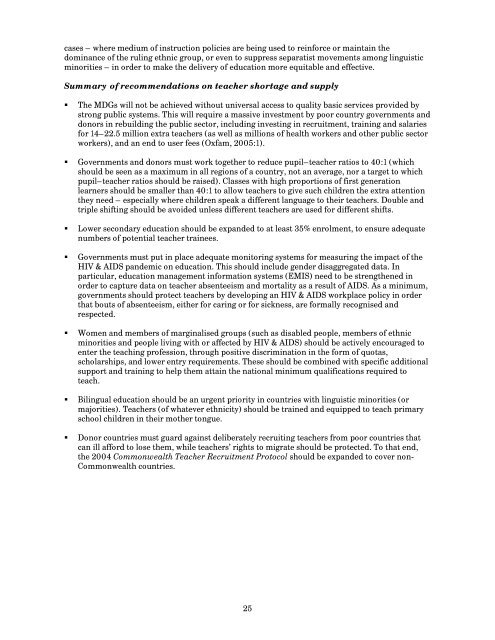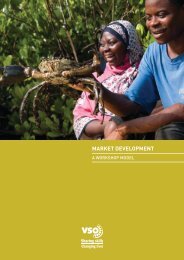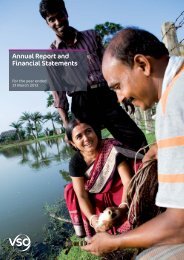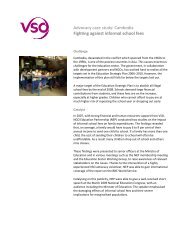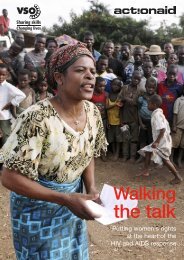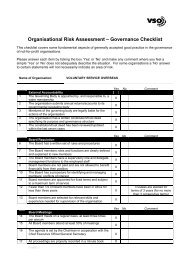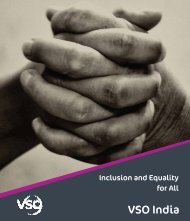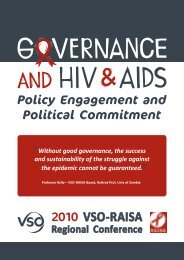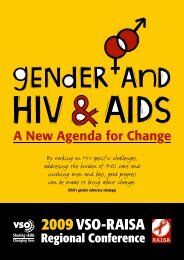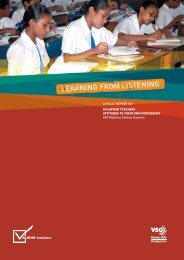communities (Seel, 2003). There is a clear pattern of high dropout and repetition rates in areaswhere the language of instruction cannot be understood by the children. In such a situation –where children can’t understand teachers and teachers can’t understand children, little learning ispossible.Similarly, in Bangladesh, the dropout rate <strong>for</strong> ethnic minority children in the Chittagong Hill Tractsis again much higher than the estimated national rate, with more than 60% of children droppingout, especially in the early years (Asian Development Bank, 2001). Not having teachers who speaka child’s first language in early grades contributes to the high dropout rate of indigenous childrenfrom primary school. In schools such as these that are attended primarily by children fromindigenous minority groups, the majority of teachers speak the dominant Bangla language only. Notraining is provided <strong>for</strong> the teaching of or through indigenous languages, as indigenous languagesare not officially recognised by the government. Ethnic minority children in Bangladesh consultedby Save the Children felt that they do not have access to primary education because teachers andschool administrators deny them admission as they often do not speak fluent Bangla (Save theChildren, 2005).Ethnic minority girls suffer particularly from lack of access to education in their mother tongue.Studies in Africa and Latin America have shown that girls who learn in familiar languages ‘stay inschool longer, do better on achievement tests, and repeat grades less often than girls who do notget home language instruction’ (UNESCO, 2005e).There is clearly a need <strong>for</strong> both the recruitment of teachers from ethnic minority communities toteach in schools that serve those communities, as well as a revision of policies that impose anational language on children who speak a different language at home.‘To expand access <strong>for</strong> ethnic groups, teachers or teacher aides from the target ethnicgroup are particularly helpful in their ability to connect with the students as powerfulrole models. Bilingual schools have also been effective. In Mali, bilingual programswere associated with large declines in dropout and repetition, and rural studentsoutscored urban children’ (World Bank, 2006:138).Recruiting and supporting more ethnic minority teachers will ensure that there are sufficientnumbers of teachers who are able to teach in local languages, provide education that is relevant tolocal realities and act as role models <strong>for</strong> ethnic minority children to progress through the educationsystem. To make this possible, it may be necessary to make teacher training entry requirementsmore flexible to compensate <strong>for</strong> the low level of education among ethnic minority applicants. At thesame time, such trainees should receive the extra support they need during pre-service and inservicetraining to enable them to meet the minimum standards required to teach and deliver thesame quality of education as other teachers. It may also be necessary to decentralise control ofteacher recruitment, training and posting in order to develop teacher training curricula in all thedifferent languages spoken, and provide schools with teachers who can speak the same language asthe children and communities they serve– as has been recommended by the World Bank:‘A further challenge is that where there are many languages, <strong>for</strong>merly centralizedapproaches to teacher development and deployment will need to be modified. Toaddress this challenge, countries can decentralize the recruitment of teachercandidates and pre- and in-service teacher training can also be managed regionallyrather than centrally’ (World Bank, 2005:3).Mother tongue medium of instruction is especially important <strong>for</strong> first generation learners and <strong>for</strong>all children in early grades. Bilingual education, in which children are first taught in their mothertongue and later taught the national or regional language as a second language, which only laterstill (<strong>for</strong> example, in secondary schools) is used as the medium of instruction, is evidently an urgentpriority in countries with linguistic minorities (or majorities). Indeed, learning the national orregional language may well be an expressed aspiration of ethnic minority communities, as it canenable them to participate in, <strong>for</strong> example, local and national elections or to access social andhealth services. Pressure from education coalitions and teachers’ unions may be needed in some24
cases – where medium of instruction policies are being used to rein<strong>for</strong>ce or maintain thedominance of the ruling ethnic group, or even to suppress separatist movements among linguisticminorities – in order to make the delivery of education more equitable and effective.Summary of recommendations on teacher shortage and supply• The MDGs will not be achieved without universal access to quality basic services provided bystrong public systems. This will require a massive investment by poor country governments anddonors in rebuilding the public sector, including investing in recruitment, training and salaries<strong>for</strong> 14–22.5 million extra teachers (as well as millions of health workers and other public sectorworkers), and an end to user fees (Oxfam, 2005:1).• Governments and donors must work together to reduce pupil–teacher ratios to 40:1 (whichshould be seen as a maximum in all regions of a country, not an average, nor a target to whichpupil–teacher ratios should be raised). Classes with high proportions of first generationlearners should be smaller than 40:1 to allow teachers to give such children the extra attentionthey need – especially where children speak a different language to their teachers. Double andtriple shifting should be avoided unless different teachers are used <strong>for</strong> different shifts.• Lower secondary education should be expanded to at least 35% enrolment, to ensure adequatenumbers of potential teacher trainees.• Governments must put in place adequate monitoring systems <strong>for</strong> measuring the impact of theHIV & AIDS pandemic on education. This should include gender disaggregated data. Inparticular, education management in<strong>for</strong>mation systems (EMIS) need to be strengthened inorder to capture data on teacher absenteeism and mortality as a result of AIDS. As a minimum,governments should protect teachers by developing an HIV & AIDS workplace <strong>policy</strong> in orderthat bouts of absenteeism, either <strong>for</strong> caring or <strong>for</strong> sickness, are <strong>for</strong>mally recognised andrespected.• Women and members of marginalised groups (such as disabled people, members of ethnicminorities and people living with or affected by HIV & AIDS) should be actively encouraged toenter the teaching profession, through positive discrimination in the <strong>for</strong>m of quotas,scholarships, and lower entry requirements. These should be combined with specific additionalsupport and training to help them attain the national minimum qualifications required toteach.• Bilingual education should be an urgent priority in countries with linguistic minorities (ormajorities). <strong>Teachers</strong> (of whatever ethnicity) should be trained and equipped to teach primaryschool children in their mother tongue.• Donor countries must guard against deliberately recruiting teachers from poor countries thatcan ill af<strong>for</strong>d to lose them, while teachers’ rights to migrate should be protected. To that end,the 2004 Commonwealth Teacher Recruitment Protocol should be expanded to cover non-Commonwealth countries.25


